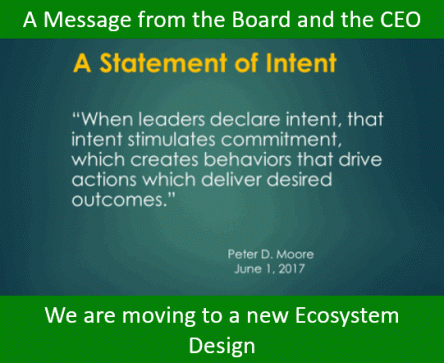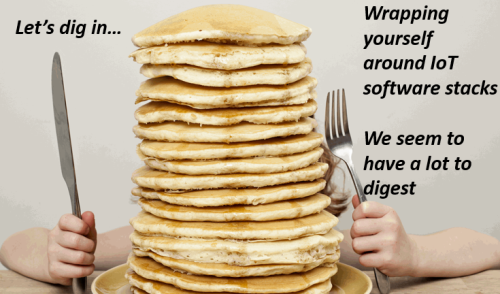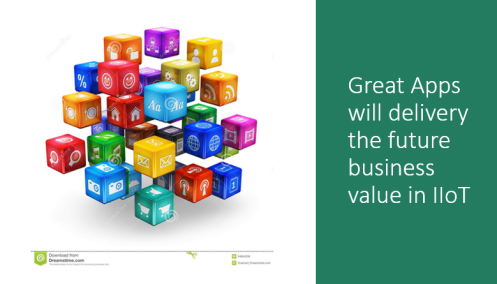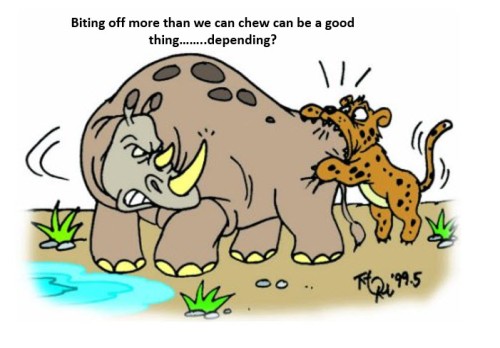 Ecosystems have become a really hot topic. As we gain the understanding of what a dual strategy approach to what our business could look like, you need to recognize what you still need control of, those you call your core assets. Yet at the same time, to explore and expand out more today we need to build better external collaborative approaches.
Ecosystems have become a really hot topic. As we gain the understanding of what a dual strategy approach to what our business could look like, you need to recognize what you still need control of, those you call your core assets. Yet at the same time, to explore and expand out more today we need to build better external collaborative approaches.
To achieve this reaching out and collaborating will require participating in platforms and building up your Ecosystem Management understanding.
The word “Ecosystem” is getting as much “air time” as the general use of the word “innovation” in business recently. It generates buzz, it projects the impression you are looking to the future, managing your business in that progressive, outward way, that shareholders and your employees love to here.
Well as we well only well know with innovation, if it does not align to strategy, integrate within the business activities, it stays a little out on one side. Also, innovation stays so often a necessity to “call upon” but not as your core focus of activity. That focus still is, sadly today focused on managing the assets for short-term performance, where the consistent focus is always on efficiency and effectiveness to “work or sweat those assets”. Maybe we might be seeing a change in ecosystem management design. More of the “assets” outsourced or in collaborative partnerships.
Well, Ecosystems are entering the lexicon of top management. It does sound good to talk about “building our ecosystem” in every possible way. You need to ask though, has management actually sat down and defined the type of ecosystem it wants to design, to participate in, or become part of. Or do this simply happen, a sort of drifting into, a grand experiment, as if that made real progressive sense? Let’s take a different approach
What if the CEO and the board decided to open up the discussion around the future pathway, one of managing within a federation of ecosystems.
Read more
 Software stacks. This conquers up a certain mystery for me, so I decided to order up a plate to see if I can digest all they seem to be offering.
Software stacks. This conquers up a certain mystery for me, so I decided to order up a plate to see if I can digest all they seem to be offering. Ecosystems in our business thinking have suddenly become of age, they can enable cross-cutting innovation to be delivered in highly collaborative and dynamic ways. Understanding the value of working within an ecosystem is becoming critical to understand.
Ecosystems in our business thinking have suddenly become of age, they can enable cross-cutting innovation to be delivered in highly collaborative and dynamic ways. Understanding the value of working within an ecosystem is becoming critical to understand. There are twin forces at work, feeding off each other and innovation can become the greater unifier. We are facing greater disruption and an increasing innovation and technology pace. These are constantly combining, relentlessly adding a new shape to our future. We are actually caught up in a very revolutionary period.
There are twin forces at work, feeding off each other and innovation can become the greater unifier. We are facing greater disruption and an increasing innovation and technology pace. These are constantly combining, relentlessly adding a new shape to our future. We are actually caught up in a very revolutionary period. The broad use of ‘open’ does seem to have very different interpretations, especially when it comes to platforms or cloud-ready architecture.
The broad use of ‘open’ does seem to have very different interpretations, especially when it comes to platforms or cloud-ready architecture.
 Technology is radically altering our need for innovation. We see increasingly innovation is feeding off the “digital response rate” and how we build and design the application software will transform IIoT as it has for our personal world (B2C), where we download apps on a daily basis to solve a problem or to improve our understanding.
Technology is radically altering our need for innovation. We see increasingly innovation is feeding off the “digital response rate” and how we build and design the application software will transform IIoT as it has for our personal world (B2C), where we download apps on a daily basis to solve a problem or to improve our understanding. Ecosystems have become a really hot topic. As we gain the understanding of what a dual strategy approach to what our business could look like, you need to recognize what you still need control of, those you call your core assets. Yet at the same time, to explore and expand out more today we need to build better external collaborative approaches.
Ecosystems have become a really hot topic. As we gain the understanding of what a dual strategy approach to what our business could look like, you need to recognize what you still need control of, those you call your core assets. Yet at the same time, to explore and expand out more today we need to build better external collaborative approaches. You certainly have to make choices in life in where you focus your energy, otherwise, it gets way to complicated. For me to learn about Ecosystems and Platforms I have chosen a “select” group of IIoT players or advisors in their field to concentrate upon. Increasingly the insights and leading knowledge seems to be less coming out of the Big Consulting firms but more from those actually operating in the Industrial world (IIoT players).
You certainly have to make choices in life in where you focus your energy, otherwise, it gets way to complicated. For me to learn about Ecosystems and Platforms I have chosen a “select” group of IIoT players or advisors in their field to concentrate upon. Increasingly the insights and leading knowledge seems to be less coming out of the Big Consulting firms but more from those actually operating in the Industrial world (IIoT players). I had mentioned in a related post on my other
I had mentioned in a related post on my other 